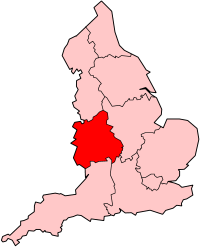Birchills Power Station
Birchills Power Station (or Walsall Power Station) was a coal-fired power station near Walsall in the West Midlands, England.
| Birchills Power Station | |
|---|---|

| |
| Country | England |
| Location | West Midlands |
| Coordinates | 52.596089°N 1.997785°W |
| Status | Decommissioned |
| Commission date | 1949 |
| Decommission date | 1982 |
| Thermal power station | |
| Primary fuel | Coal |
grid reference SP001998 | |
History
The first power station on the site was built for Walsall Corporation. Work began in 1914, and electricity was being generated by 1916, although the project was not officially completed until 1922.
In 1923 the electricity plant comprised 2 × 4 MW and 1 × 5 MW steam turbines driven by 100,000 lb/hr (12.60 kg/s) of steam.[1] Electricity was available as 3-phase AC, at 400 and 230 V, and DC at 210 and 105 V. In 1923 the station generated 13.17 GWh of electricity, some of this was used in the plant, the total amount sold was 10.22 GWh. The revenue from sales of current was £84,927, this gave a surplus of revenue over expenses of £40,522.[1]
Cooling water was supplied by a pumping station on the Anson Branch canal, equipped with two Mather and Platt pumps capable of delivering 10.6 million gallons (48 Megalitres) per day. Spent water was discharged into the Wyrley and Essington Canal. Ownership of the station passed to the West Midlands Joint Electricity Authority in 1927, and then to the British Electricity Authority following nationalisation in 1948.[2]
Construction of a second station, Walsall B, began soon after nationalisation.[2] The station was officially opened on 30 September 1949. Comprising six cooling towers and six chimneys, with a total output of 191MW, (one of the largest and high output power plants, when it was first operational in 1949) the station burned 'slack' coal, which consisted of fragments of coal and coal dust. Coal was delivered by road, rail and canal. Water from the canal was used for cooling. The electricity output from the station is shown in the table.[3][4][5]
| Year | 1946 | 1955 | 1956 | 1957 | 1958 | 1959 | 1961 | 1962 | 1963 |
|---|---|---|---|---|---|---|---|---|---|
| Station output, GWh | 13.212 | 13.426 | 11.414 | 5.601 | 0.228 | 3.423 | 2.953 | 2.003 | 4.256 |
The station closed in October 1982 after 33 years in use, and the stub of railway serving it west of Ryecroft Junction, was closed at the same time. The power station was closed as it was no longer deemed to be efficient, when much newer coal power stations built later in the 1960s, 1970s and 1980s with six or eight cooling towers can generate up to ten times more electricity as technology improves with bigger generators becoming more apparent on less coal consumption i.e. 2000MW+ than Birchills could.
It stood dormant or mothballed for nearly five years afterwards, finally being demolished in March 1987.
The substation it fed power to, also in Birchills is still in existence today, but is now fed from Rugeley 'B' station.
References
- Electricity Commission (1925). Electricity Supply - 1920-1923. London: HMSO. pp. 94–97, 326–31.
- Shill (2011)
- Garrett, Frederick C. (ed) (1959). Garcke's Manual of Electricity Supply vol. 56 1958-59. London: Electrical Press. pp. A-33, A-113.CS1 maint: extra text: authors list (link)
- CEGB, Annual report and accounts, 1961, 1962 & 1963
- Electricity Commission, Generation of Electricity in Great Britain year ended 31st December 1946. London: HMSO, 1947.
Bibliography
- Ray Shill (Winter 2011). "BCN Branches and Byeways: Ansons Branch". Boundary Post. Birmingham Canal Navigations Society. 191.
